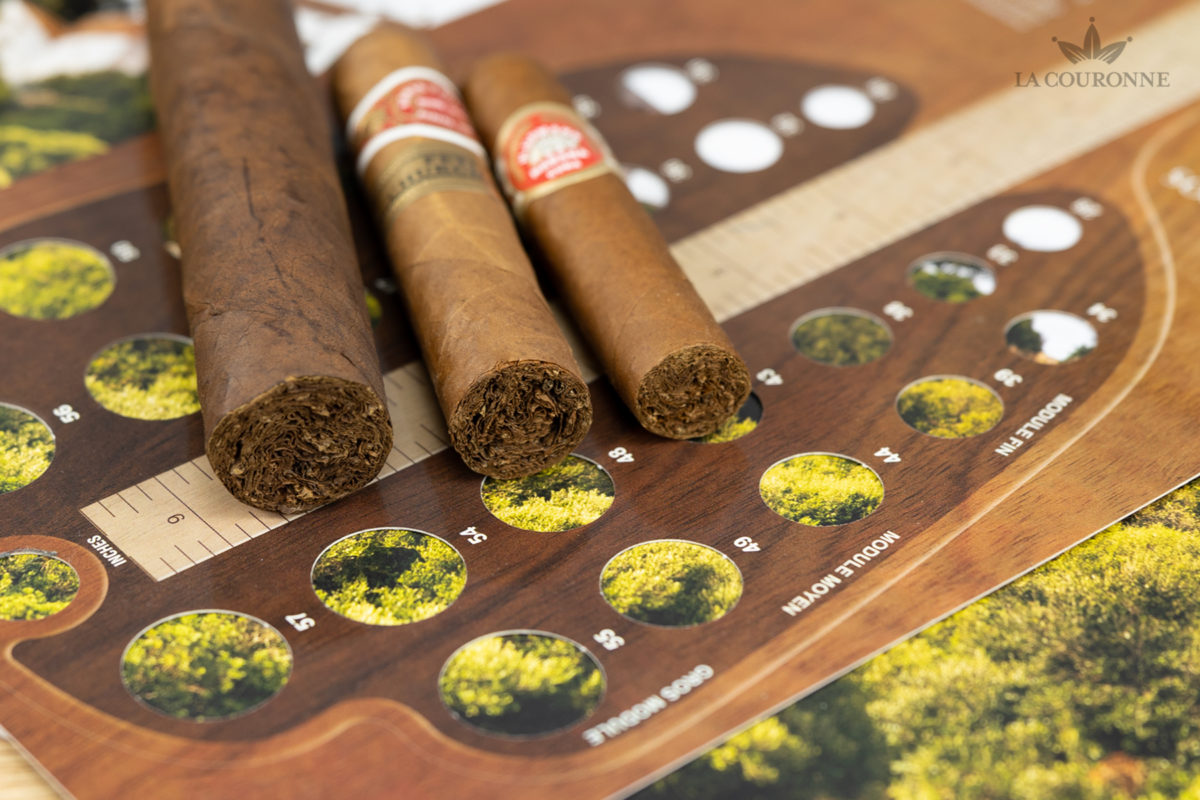L'académie du cigare, All about cigars
How to choose your cigar's cepo?
Since the 1990s, trends in cigar diameters have undergone a profound change. Whereas the 20th century saw a marked attraction for cigars in cepo 26 to 48, aficionados are now turning to cigars with larger diameters. Today, worldwide sales show a craze for cigars of cepo 50 and above. So what are the reasons for this change in consumption habits, and what criteria should be considered when choosing a cepo?
What is a cepo?
A cigar's cepo refers to its diameter. It is expressed in 64ths ofan inch (1 inch = 2.54 cm). Today's premium cigars generally offer cepo between 26 and 60, but there are also modules that can go up to cepo 80. This is the case, for example, with Asylum 13 Goliath.
To help you quickly visualize the size of your cigars, you can consult this conversion guide.
| Cepo | Width (in inches) | Width (in mm) |
| 26 | 0.41 | 10.3 |
| 28 | 0.44 | 11.11 |
| 30 | 0.47 | 11.9 |
| 32 | 0.5 | 12.7 |
| 34 | 0.53 | 13.49 |
| 36 | 0.56 | 14.28 |
| 38 | 0.59 | 15 |
| 40 | 0.63 | 15.8 |
| 42 | 0.66 | 16.66 |
| 44 | 0.69 | 17.46 |
| 46 | 0.72 | 18.25 |
| 48 | 0.75 | 19 |
| 50 | 0.78 | 19.84 |
| 52 | 0.81 | 20.63 |
| 54 | 0.84 | 21.43 |
| 56 | 0.88 | 22.22 |
| 58 | 0.91 | 23.01 |
| 60 | 0.94 | 23.81 |
| 62 | 0.97 | 24.6 |
| 64 | 1 | 25.4 |
What influence does cepo have on tasting?
The diameter of your cigar influences the perception of its aromas in two ways. Firstly, the diameter will determine how you perceive the smoke. The thinner your cigar, the faster it burns. This has the effect of heating the smoke, which can increase the strength and bitterness of your cigars.
The diameter of your cigar will also influence the perception of its flavours and aromas. As a general rule, a cigar is made up of a Wrapper, a Binder and three filler leaves. While the balance between these three elements helps to create a harmonious tasting experience, it is the composition of the filler that primarily determines the richness of your module's taste. The thicker the cigar, the more you can perceive its richness and complexity. Conversely, the rapid burning of a thin cigar does not offer the same possibilities for developing flavours over time.
What's more, because of the ratio of wrapper to filler, the stronger tobacco is likely to be more noticeable and take precedence over other aromas. Even so, some cigar aficionados prefer the finer modules, as they allow the flavour qualities of the wrapper leaves to be better appreciated. As always with cigars, it's a question of taste.
Criteria to consider when choosing your cepo
The choice of a cepo depends on several factors and can vary from one situation to another. The first thing to consider before choosing the diameter of your cigar is the time you have available to smoke it. Generally speaking, the thicker the cigar, the longer it will take to smoke. This is due to the slowness of combustion. If you only have a short time available, it's best to opt for a cigar with a cepo of less than 50.
Your choice of cepo will also depend on your experience and taste. For example, beginner smokers are advised to start smoking cigars with a cepo of less than 40. This allows them to develop their palate smoothly, without being overwhelmed by too much smoke.
Another criterion not to be overlooked when choosing your cepo is the accessories you have in your possession. Some cigar cutters are not suitable for large diameters, and it's always a shame not to be able to enjoy a cigar when you feel like it. So before you invest in thicker modules, make sure you have the accessories compatible with their diameter.
How do you explain the craze for thick cigars?
Several phenomena may explain the contemporary appeal of thick cigars. As we saw earlier, modules with a large cepo allow a better appreciation of their "evolutionary" side. This makes it easier to perceive their full richness and complexity. The slower combustion of this type of cigar also favours a better rendering of flavours.
Some experts explain this trend by the crisis that hit Cuban cigars from the 90s onwards. Prior to this period, the "corona" format was the benchmark. However, many modules had draw problems, which contributed to a mistrust of this type of format and prompted some cigar aficionados to turn to larger modules. As time went by, the "robustos" became the reference format.
For some, the craze for large-diameter cigars is just another fad. In their view, it reflects the idea that a cigar's cepo reflects the smoker's degree of power and opulence. Like Tony Montana in Scarface, the larger the cigar, the more successful the individual.
Is a large-diameter cigar necessarily better?
No, a large-diameter cigar is not necessarily better. It all depends on the blend it contains and the skill with which it was made. Take the Lancero, for example. This cepo 38 format was Fidel Castro's favorite. It is still the reference format for premium cigar producers to taste a blend. It's the format that best allows you to appreciate the full power and complexity of a cigar. However, this format is rarely marketed today, as it's a cigar that requires time and specialized skills to roll.
Choosing your cepo is above all a matter of taste. What's more, it's entirely possible to vary the pleasures of the blends on offer. The more you taste cigars in different formats, the better you'll be able to determine which cepo suits you best.

